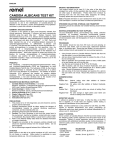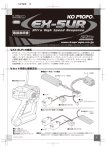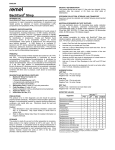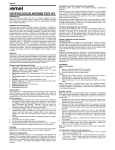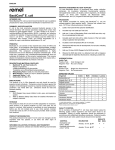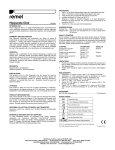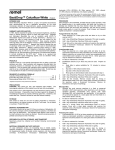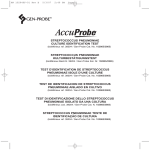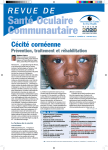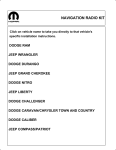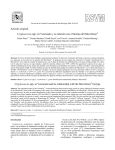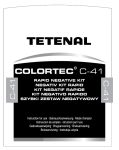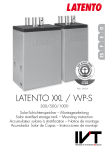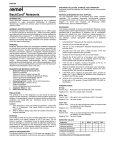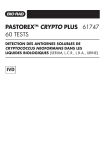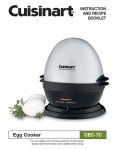Download BactiCard Candida - Thermo Scientific
Transcript
ENGLISH unused test cards at 2-8°C in the foil pouch provided. Seal to protect from moisture. ® BactiCard Candida INTENDED USE ® Remel BactiCard Candida is recommended for use in qualitative procedures to aid in the identification of Candida albicans by the rapid detection of L-proline aminopeptidase and β-galactosaminidase. SUMMARY AND EXPLANATION Candida albicans is the species of yeast most frequently isolated from clinical specimens. Traditionally, C. albicans has been 1 Studies have presumptively identified by the germ tube test. indicated that up to 5% of clinical isolates of C. albicans are germ tube negative. Additionally, early pseudohyphae of Candida tropicalis may be confused with germ tube formation. Perry and Miller evaluated the use of 4-methylumbelliferyl-N-acetyl-β-D-galactosaminide to detect an enzyme produced by C. albicans, β-galactosaminidase 2 (MUGAL). In further testing, Perry et al. modified the test substrate and added a second substrate for detection of L-proline 3 The combined use of two substrates aminopeptidase (PRO). provided for a method with improved sensitivity and specificity to aid in the identification of Candida spp. While other species of yeast were found to be positive for one enzyme or the other, C. albicans tested positive for both enzymes. This substrate combination provides a rapid, nonmicroscopic method to aid in the identification of 4 C. albicans as effectively as the germ tube test. PRINCIPLE ® BactiCard Candida consists of two separate test circles. The MUGAL circle contains the substrate, 4-methylumbelliferyl-N-acetylβ-D-galactosaminide. In the presence of the enzyme, β-galactosaminidase, this substrate releases 4-methylumbelliferone, a highly fluorescent compound detectable by longwave ultraviolet light. The PRO circle contains the substrate, L-proline-β-naphthylamide. In the presence of the enzyme, L-proline aminopeptidase, the substrate is hydrolyzed and reacts with the Color Developer to form a red color. REAGENTS AND MATERIALS SUPPLIED ® 1. BactiCard Candida Test Cards (25) Reactive Ingredients: L-Proline-β-naphthylamide (PRO) 4-Methylumbelliferyl-N-acetyl-β-D-galactosaminide (MUGAL) 2. Rehydrating Fluid (1 bottle, 6.0 ml) with preservative 3. Color Developer (1 bottle, 6.0 ml) Reactive Ingredient: 0.02% ρ-Dimethylaminocinnamaldehyde 4. MUGAL Reagent (1 bottle, 6.0 ml) Reactive Ingredient: 4% Sodium Hydroxide 5. Applicator Sticks (1 vial) 6. Instructions for Use (IFU) PRECAUTIONS This product is for In Vitro diagnostic use and should be used by properly trained individuals. Precautions should be taken against the dangers of microbiological hazards by properly sterilizing specimens, containers, and media after use. Directions should be read and followed carefully. Caution! 1. MUGAL Reagent may cause irritation to skin, eyes, and respiratory system. 2. Color Developer is toxic and harmful by inhalation, contact with skin, or if swallowed. May impair fertility or cause harm to unborn child. 3. Refer to Material Safety Data Sheet for detailed information on reagent chemicals. STORAGE This product is ready for use and no further preparation is necessary. Store product in its original container at 2-8°C until used. Do not freeze or overheat. Allow product to equilibrate to room temperature before use. Do not incubate prior to use. Once opened, maintain PRODUCT DETERIORATION This product should not be used if (1) the color has changed, (2) the expiration date has passed, or (3) there are other signs of deterioration. Note: Precipitate formation in the Color Developer at storage temperatures is common and does not affect performance of the test. SPECIMEN COLLECTION, STORAGE, AND TRANSPORT Specimens should be collected and handled following recommended 5 guidelines. MATERIALS REQUIRED BUT NOT SUPPLIED (1) Loop sterilization device, (2) Inoculating loop, swabs, collection containers, (3) Incubators, alternative environmental systems, (4) Supplemental media, (5) Quality control organisms, (6) Longwave ultraviolet light (Woods Lamp). PROCEDURE ® Test isolates acceptable for testing with BactiCard Candida are 1872 hour, pure cultures of yeast. 1. 2. 3. 4. 5. 6. 7. 8. 9. ® Label BactiCard Candida with the specimen identification. Inoculate only one isolate per test card. ® Add one (1) drop of BactiCard Candida Rehydrating Fluid to each test circle. Do not oversaturate the test area. Inoculate each test circle with a visible inoculum of the test isolate using an applicator stick (provided). Incubate at room temperature for five (5) minutes. ® Add one (1) drop of BactiCard Candida Color Developer to the PRO test circle. Observe for a red color development within 30 seconds, indicating a positive test. ® Add one (1) drop of BactiCard Candida MUGAL Reagent to the MUGAL test circle. Observe the MUGAL test circle in a darkened room with a longwave ultraviolet light for bright blue fluorescence, indicating a positive test. INTERPRETATION PRO Test: Positive Test - Red color development within 30 seconds Negative Test - No color change MUGAL Test: Positive Test - Bright blue fluorescence Negative Test - No fluorescence EXPECTED VALUES C. albicans is positive for both tests. If either the PRO or the MUGAL is negative or if both tests are negative, further testing is required for identification of the yeast isolate. Note: Candida dubliniensis is also positive for both PRO and MUGAL. Growth at elevated temperatures and colony morphology on differential media have been reported to facilitate differentiation of 6,7 C. albicans and C. dubliniensis. QUALITY CONTROL ® All lot numbers of BactiCard Candida have been tested using the following quality control organisms and have been found to be acceptable. Testing of control organisms should be performed in accordance with established laboratory quality control procedures. If aberrant quality control results are noted, patient results should not be reported. CONTROL INCUBATION Candida albicans ® ATCC 10231 Cryptococcus neoformans ® ATCC 32045 Aerobic, 5 min. @ Room Temperature Aerobic, 5 min. @ Room Temperature RESULTS PRO MUGAL + + – – ENGLISH PERFORMANCE CHARACTERISTICS ® BactiCard Candida was evaluated with 711 strains of yeast and demonstrated greater than 99% agreement with conventional identification methods. All 152 strains of C. albicans tested were PRO and MUGAL positive. Five of 152 strains were germ tube negative (3.3%). Of the 559 additional yeast isolates evaluated, six strains were positive for both enzymes (3 of 13 Candida rugosa, 2 of 13 Candida stellatoidea, and 1 of 6 Trichosporon beigelii, which is morphologically distinct from C. albicans). LIMITATIONS 1. This test is only part of the overall scheme for identification of yeasts. Further testing is required for definitive identification. 1,5 Consult appropriate references for further instructions. 2. Testing cultures mixed with bacteria or other species of yeast may yield aberrant results. 3. Testing cultures less than 18 hours old may result in falsenegative reactions. 4. Extending the incubation of the test card beyond the specified time parameter may result in a false-positive reaction. 5. Some species of yeast may appear to fluoresce yellow on the MUGAL test circle and should not be confused with the blue fluorescence of a true positive reaction. 6. C. dubliniensis, first described in 1995, also produces germ 8 tubes and chlamydospores. Growth at elevated temperatures and morphology on differential media have been found to 6,7 facilitate differentiation of C. albicans and C. dubliniensis. 2. 3. 4. 6. 7. 8. Murray, P.R., E.J. Baron, J.H. Jorgensen, M.L. Landry, and M.A. Pfaller. 2007. Manual of Clinical Microbiology. 9th ed. ASM Press, Washington, D.C. Al Mosaid, A., D. Sullivan, I.F. Salkin, D. Shanley, and D.C. Coleman. 2001. J. Clin. Microbiol. 39:323-327. Wabale, V.R., A.S. Kagal, R.S. Mani, and R. Bharadwaj. 2007. Indian J. Med. Microbiol. 25:304-305. Retrieved October 1, 2008 from: http://www.ijmm.org/text.asp?2007/25/3/304/34787. Sullivan, D.J., T.J. Westerneng, K.A. Haynes, D.E. Bennett, and D.C. Coleman. 1995. Microbiology. 141:1507-1521. PACKAGING ® REF R21106, BactiCard Candida .................................... 25 Tests/Kit Symbol Legend REF Catalog Number IVD In Vitro Diagnostic Medical Device LAB For Laboratory Use Consult Instructions for Use (IFU) Temperature Limitation (Storage Temp.) LOT Winn, W., S. Allen, J. William, E. Koneman, G. Procop, P. Schreckenberger, and G. Woods. 2006. Koneman’s Color Atlas and Textbook of Diagnostic Microbiology. 6th ed. Lippincott Williams and Wilkins, Baltimore, MD. Perry, J.L. and G.R. Miller. 1987. J. Clin. Microbiol. 25:2424-2425. Perry, J.L., G.R. Miller, and D.L. Carr. 1990. J. Clin. Microbiol. 28:614-615. Dealler, S.F. 1991. J. Clin. Microbiol. 29:1081-1082. Batch Code (Lot Number) Use By (Expiration Date) EC REP BIBLIOGRAPHY 1. 5. European Authorized Representative BactiCard® is a registered trademark of Remel Inc. ATCC® is a registered trademark of American Type Culture Collection. IFU 21106, Revised February 2, 2009 12076 Santa Fe Drive, Lenexa, KS 66215, USA General Information: (800) 255-6730 Technical Services: (800) 447-3641 Order Entry: (800) 447-3635 Local/International Phone: (913) 888-0939 International Fax: (913) 895-4128 Website: www.remel.com Email: [email protected] Printed in U.S.A. GERMAN 3. ® BactiCard Candida Verwendungszweck ® Remel BactiCard Candida ist zur Verwendung in qualitativen Verfahren zur Identifizierung von Candida albicans durch einen schnellen Nachweis von L-Prolin-Aminopeptidase und β-Galactosaminidase empfohlen. ZUSAMMENFASSENDE ERKLÄRUNG Candida albicans ist die Hefezellenart, die am häufigsten in klinischen Proben isoliert wird. Früher wurde C. albicans vermeintlich 1 unter Verwendung des Keimschlauchtests identifiziert. Studien haben gezeigt, dass bis zu 5 % der klinischen C. albicans-Isolate negativ auf Keimschlauchbildung sind. Darüber hinaus können Pseudohyphen von Candida tropicalis in frühen Stadien mit der Keimschlauchbildung verwechselt werden. Perry und Miller untersuchten die Verwendung von 4-Methylumbelliferyl-N-Acetyl-β-DGalactosaminid zum Nachweis eines Enzyms, das von C. albicans 2 gebildet wird, der β-Galactosaminidase (MUGAL). Perry et al. modifizierten das Testsubstrat in weiteren Tests und fügten ein zweites Substrat zum Nachweis von L-Prolin-Aminopeptidase (PRO) 3 hinzu. Die kombinierte Verwendung zweier Substrate führte zur Entwicklung einer Methode, die eine verbesserte Sensitivität und Spezifität für die Identifizierung von Candida spp. aufweist. Während andere Hefearten entweder auf das eine oder das andere Enzym reagieren, wurde die positive Reaktion von C. albicans auf beide Enzyme in Tests nachgewiesen. Diese Substratverbindung bietet eine schnelle Methode ohne Mikroskop zur Identifizierung von 4 C. albicans, die genau so effektiv wie der Keimschlauchtest ist. TESTPRINZIP ® BactiCard Candida besteht aus zwei separaten Testkreisen. Der MUGAL-Kreis beinhaltet das Substrat, 4-Methylumbelliferyl-N-Acetylβ-D-Galactosaminid. Bei Vorhandensein des Enzyms βGalactosaminidase setzt dieses Substrat 4-Methylumbelliferon frei, eine hochfluoreszente Verbindung, die durch langwelliges, ultraviolettes Licht nachweisbar ist. Der PRO-Kreis beinhaltet das Substrat L-Prolin-β-Naphthylamid. Bei Vorhandensein des Enzyms LProlin-Aminopeptidase wird das Substrat hydrolysiert und reagiert mit dem Farbentwickler, was zur Erzeugung einer roten Farbe führt. IM LIEFERUMFANG ENTHALTENE REAGENZIEN UND MATERIALIEN ® 1. BactiCard Candida-Testkarten (25) Reaktive Inhaltsstoffe: L-Prolin-β-Naphthylamid (PRO) 4-Methylumbelliferyl-N-Acetyl-β-D-Galactosaminid (MUGAL) 2. Rehydrierende Flüssigkeit (1 Flasche, 6,0 ml) mit Konservierungsmittel 3. Farbentwickler (1 Fläschchen, 6,0 ml) Reaktiver Inhaltsstoff: 0,02 % ρ-Dimethylaminocinnamaldehyd 4. MUGAL-Reagenz (1 Flasche, 6,0 ml) Reaktiver Inhaltsstoff: 4 % Natriumhydroxid 5. Applikatorstäbchen (1 Röhrchen) 6. Gebrauchsanweisung (IFU) VORSICHTSMASSNAHMEN Dieses Produkt ist für die Verwendung in der In-vitro-Diagnostik bestimmt und sollte nur von entsprechend geschulten Personen verwendet werden. Mikrobiologischen Gefahren sollte vorgebeugt werden, indem Proben, Behälter und Transportmedien nach Gebrauch sterilisiert werden. Die Gebrauchsanweisung muss sorgfältig gelesen und genau befolgt werden. Vorsicht: 1. Das MUGAL-Reagens kann Reizungen von Haut, Augen und Atemwegen auslösen. 2. Der Farbentwickler ist giftig und kann bei Einatmung, bei Kontakt mit der Haut bzw. bei Verschlucken Gesundheitsschäden hervorrufen. Kann die Fruchtbarkeit beeinträchtigen oder ungeborene Säuglinge schädigen. Für genaue Angaben zur chemischen Zusammensetzung der Reagenzien siehe Datenblatt für Materialsicherheit. LAGERUNG Dieses Produkt ist ohne weitere Vorbereitung gebrauchsfertig. Das Produkt sollte in seinem Originalbehälter im Dunkeln bei 2-8°C bis zum Gebrauch aufbewahrt werden. Nicht einfrieren oder überhitzen. Vor Verwendung auf Zimmertemperatur bringen. Vor dem Gebrauch nicht inkubieren. Sobald die Verpackung der Testkarten geöffnet ist, sollten nicht verwendete Testkarten in der mitgelieferten Folientasche bei 2-8°C aufbewahrt werden. Zum Schutz vor Feuchtigkeit verschließen. BEEINTRÄCHTIGUNG DER PRODUKTQUALITÄT Dieses Produkt sollte bei (1) einer Farbänderung, (2) beim Überschreiten des Verfallsdatums und (3) beim Auftreten anderer Anzeichen eines Qualitätsverlusts nicht verwendet werden. Hinweis: Eine Ausfällung des Farbentwicklers oder Farbänderung ist üblich und beeinträchtigt nicht die Testleistung. PROBENENTNAHME, LAGERUNG UND TRANSPORT Die Probenentnahme und -handhabung sollte unter Berücksichtigung 5 der empfohlenen Richtlinien erfolgen. BENÖTIGTE MATERIALIEN (NICHT IM LIEFERUMFANG ENTHALTEN) (1) Gerät zur Sterilisation der Inokulationsschlinge, (2) Inokulationsschlinge, Abstrichbesteck, Probenbehälter, (3) Inkubatoren, andere Klimasysteme, (4) zusätzliche Medien, (5) Qualitätskontrollorganismen, (6) langwelliges, ultraviolettes Licht (Wood-Lampe). VERFAHREN ® Als Testisolate für den BactiCard Candida-Test eignen sich 18-72 Stunden alte, reine Hefekulturen. 1. 2. 3. 4. 5. 6. 7. 8. 9. ® BactiCard Candida mit einer Probenkennung etikettieren. Nur ein Isolat pro Testkarte inokulieren. ® CandidaDem Testkreis einen (1) Tropfen BactiCard rehydrierender Flüssigkeit zugeben. Den Testbereich nicht übersättigen. Jeden Testkreis mit einem sichtbaren Inokulum des Testisolats mithilfe eines Applikatorstäbchens (im Lieferumfang enthalten) inokulieren. Fünf (5) Minuten bei Raumtemperatur inkubieren. ® Dem PRO-Testkreis einen (1) Tropfen BactiCard CandidaFarbentwickler zugeben. Eine beobachtbare rote Farbentwicklung innerhalb von 30 Sekunden weist auf einen positiven Test hin. ® Dem MUGAL-Testkreis einen (1) Tropfen BactiCard CandidaMUGAL-Reagenz zugeben. Eine beobachtbare helle blaue Fluoreszenz des MUGALTestkreises in einem abgedunkelten Raum mit einem langwelligen, ultravioletten Licht weist auf einen positiven Test hin. INTERPRETATION PRO-Test: Positiver Nachweis- Rote Farbentwicklung innerhalb von 30 Sekunden Negativer Nachweis- Keine Farbveränderung MUGAL-Test: Positiver Nachweis- Helle blaue Fluoreszenz Negativer Nachweis- Keine Fluoreszenz ERWARTETE WERTE Bei C. albicans reagieren beide Tests positiv. Wenn entweder der PRO- oder MUGAL-Test oder beide Tests ein negatives Ergebnis zeigen, ist weiteres Prüfen zur Identifikation der Hefeisolate erforderlich. Hinweis: Bei Candida dubliniensis reagieren ebenfalls beide Tests (PRO und MUGAL) positiv. Das Wachstum bei erhöhten Temperaturen und die Koloniemorphologie in differenzierten Medien erwies sich als geeignet, die Unterscheidung von C. albicans und 6,7 C. dubliniensis zu erleichtern. GERMAN QUALITÄTSKONTROLLE ® Alle Chargen von BactiCard Candida wurden mit den folgenden Kontrollorganismen geprüft und als tauglich befunden. Die im Rahmen der Qualitätssicherung durchgeführten Tests mit Kontrollorganismen sollten die Anforderungen anerkannter Qualitätssicherungsverfahren für Labore erfüllen. Treten im Rahmen der Qualitätskontrolle abweichende Ergebnisse auf, dürfen die Patientenergebnisse nicht verwendet werden. KONTROLLE INKUBATION Candida albicans ® ATCC 10231 Cryptococcus neoformans ® ATCC 32045 Aerobisch, 5 min. bei Raumtemperatur Aerobisch, 5 min. bei Raumtemperatur ERGEBNISSE PRO MUGAL LITERATURANGABEN 1. 2. 3. 4. 5. 6. + + – – 7. 8. LEISTUNGSMERKMALE ® BactiCard Candida wurde mit 711 Hefestämmen geprüft und zeigte eine höhere Übereinstimmung als 99% mit konventionellen Methoden zur Identifizierung. Sämtliche 152 C. albicans-Stämme wurden für PRO und MUGAL positiv getestet. Fünf der 152 Stämme waren Keimschlauch-negativ (3,3%). Bei einem der zusätzlich getesteten 559 Hefeisolate reagierten sechs Stämme auf beide Enzyme positiv (3 von 13 Candida rugosa, 2 von 13 Candida stellatoidea und 1 von 6 Trichosporon beigelii, die sich morphologisch von C. albicans unterscheiden). EINSCHRÄNKUNGEN 1. Dieser Test stellt nur einen Teil des Gesamtschemas zur Identifikation von Hefearten dar. Zur endgültigen Identifikation bedarf es weiterer Tests. Weitere Informationen können Sie der 1,5 entsprechenden Dokumentation entnehmen. 2. Testkulturen, die mit Bakterien oder anderen Hefearten durchmischt sind, können zu abweichenden Ergebnissen führen. 3. Testkulturen, die weniger als 18 Stunden alt sind, können zu falsch-negativen Reaktionen führen. 4. Die Verlängerung der Inkubation der Testkarte über den festgelegten Zeitparameter hinweg kann zu einer falschpositiven Reaktion führen. 5. Einige Hefearten können im MUGAL-Testkreis gelb fluoreszieren. Dieses sollte nicht mit der blauen Fluoreszenz einer tatsächlichen positiven Reaktion verwechselt werden. 6. C. dubliniensis, zuerst 1995 beschrieben, bildet ebenfalls 8 Keimschläuche und Chlamydosporen. Das Wachstum bei erhöhten Temperaturen und die Morphologie in differenzierten Medien erwies sich als geeignet, die Unterscheidung von. Winn, W., S. Allen, J. William, E. Koneman, G. Procop, P. Schreckenberger, and G. Woods. 2006. Koneman’s Color Atlas and Textbook of Diagnostic Microbiology. 6th ed. Lippincott Williams and Wilkins, Baltimore, MD. Perry J.L. and G.R. Miller. 1987. J. Clin. Microbiol. 25:2424–2425. Perry J.L., G.R. Miller and D.L. Carr. 1990. J. Clin. Microbiol. 28:614–615. Dealler, S.F. 1991. J. Clin. Microbiol. 29:1081–1082. Murray P.R., E.J. Baron, J.H. Jorgensen, M.L. Landry and M.A. Pfaller. 2007. Manual of Clinical Microbiology. 9th ed. ASM Press, Washington, D.C. Al Mosaid A., D. Sullivan, I.F. Salkin, D. Shanley and D.C. Coleman. 2001. J. Clin. Microbiol. 39:323–327. Wabale V.R., A.S. Kagal, R.S. Mani and R. Bharadwaj. 2007. Indian J. Med. Microbiol. 25:304–305. Retrieved October 1, 2008 from: http://www.ijmm.org/text.asp?2007/25/3/304/34787. Sullivan, D.J., T.J. Westerneng, K.A. Haynes, D.E. Bennett, and D.C. Coleman. 1995. Microbiology. 141:1507-1521. PACKUNGSGRÖSSE ® REF R21106, BactiCard Candida .................................... 25 Tests/Kit Symbollegende REF Katalog-Nummer IVD Medizinprodukt zur In-vitro-Diagnostik LAB Für den Laboreinsatz Gebrauchsanweisung beachten Temperaturbereich (Lagerungstemperatur) LOT Chargenbezeichnung (Chargennummer) Verwendbar bis (Verfallsdatum) EC REP Autorisierte Vertretung für EU-Länder BactiCard® ist eine eingetragene Marke der Remel Inc. ATCC® ist eine eingetragene Marke der American Type Culture Collection. IFU 21106. Überarbeitete Fassung vom 2009-02-02 12076 Santa Fe Drive, Lenexa, KS 66215, USA Allgemeine Informationen: (800) 255-6730 Technischer Kundendienst: (800) 447-3641 Bestellungen: (800) 447-3635 Telefon lokal/international: +1 (913) 888-0939 Faxnummer international: (913) 895-4128 Website: www.remel.com E-Mail: [email protected] Printed in USA FRENCH BactiCard® Candida UTILISATION PRÉVUE ® BactiCard Candida Remel est recommandé pour un usage au cours de procédures qualitatives afin d’aider à l’identification de Candida albicans grâce à la détection rapide de L-proline aminopeptidase et de β-galactosaminidase. RÉSUMÉ ET EXPLICATION Le candida albicans est l’espèce de levures la plus souvent isolée des échantillons cliniques. D’un point de vue historique, le candida albicans aurait été identifié à l’aide du test de germination en 1 tube. Certaines études ont toutefois démontré que jusqu'à 5 % des isolats cliniques de candida albicans sont négatifs à la germination en tube. De plus, des pseudohyphes précoces de candida tropicalis peuvent être confondus avec la formation de germes en tube. Perry et Miller ont évalué l’utilisation de 4-méthylumbelliferyl-N-acétyl-β-Dgalactosamine pour détecter une enzyme produite par les 2 candidas albicans, la galactosaminidase (MUGAL) . Dans un test ultérieur, Perry et al. ont modifié le substrat du test et ont ajouté un 3 second substrat afin de détecter la L-proline-aminopeptidase (PRO). L’utilisation combinée des deux substrats a fourni une méthode d’une sensibilité et d’une spécificité améliorées permettant d’aider à identifier les Candida spp. Tandis que d’autres espèces de levures ont été détectées positives pour l’une ou l’autre enzyme, les C. albicans ont été testés positifs pour les deux enzymes. Cette combinaison de substrats fournit une méthode rapide et nonmicroscopique d’aide à l’identification des C. albicans, aussi efficace 4 que le test de germination en tube. PRINCIPE ® BactiCard Candida consiste en deux cercles de test séparés. Le cercle MUGAL contient le substrat, 4-méthylumbelliferyl-N-acétyl-βD-galactosamine. En présence de cette enzyme, la β-galactosaminidase, ce substrat libère du 4-méthylumbelliférone, un composé fortement fluorescent détectable à l’aide de lumière ultraviolette à ondes longues. Le cercle PRO contient le substrat, L-proline-β-naphthylamide. En présence de l’enzyme, L-proline aminopeptidase, le substrat est hydrolysé et réagit au développeur de coloration pour former une couleur rouge. RÉACTIFS ET MATÉRIEL FOURNIS ® 1. Cartes de tests BactiCard Candida (25) Ingrédients réactifs : L-Proline-β-naphthylamide (PRO) 4-Méthylumbelliferyl-N-acétyl-β-D-galactosamine (MUGAL) 2. Fluide réhydratant (1 flacon, 6,0 ml) avec conservateur 3. Développeur de coloration (1 flacon, 6,0 ml) Ingrédient réactif : ρ-diméthylaminocinnamaldéhyde à 0,02 % 4. Réactif MUGAL (1 flacon, 6,0 ml) Ingrédient réactif : Hydroxyde de sodium à 4 % 5. Bâtonnets applicateurs (1 flacon) 6. Mode d'emploi (IFU) PRÉCAUTIONS Ce produit, exclusivement destiné à un usage diagnostique In Vitro, ne doit être utilisé que par des personnes dûment formées. Il faut prendre toutes les précautions contre les risques microbiologiques et il est indispensable de bien stériliser les prélèvements, les récipients et les milieux après usage. Il faut lire attentivement les instructions et les respecter scrupuleusement. Attention ! 1. Le réactif MUGAL peut irriter la peau, les yeux et les voies respiratoires. 2. Le développeur de coloration est toxique et nocif en cas d'inhalation, de contact avec la peau ou d’ingestion. Risque de réduire la fécondité. Dangereux pour l’enfant à naître. 3. Se reporter aux fiches signalétiques pour les informations détaillées sur les réactifs chimiques. STOCKAGE Ce produit est prêt à l’emploi ; aucune préparation supplémentaire n’est nécessaire. Stocker le produit dans son flacon d’origine à une température comprise entre 2 et 8°C jusqu’à son utilisation. Ne pas congeler ni surchauffer. Attendre que le produit atteigne la température ambiante avant de l’utiliser. Ne pas incuber avant utilisation. Une fois ouvert, conserver les cartes de test inutilisées à une température comprise entre -2 et 8°C dans le sachet métallisé fourni. Sceller pour les tenir à l’abri de l’humidité. DÉTÉRIORATION DU PRODUIT Ce produit ne doit pas être utilisé si (1) la couleur a changé, (2) la date de péremption est dépassée ou (3) d’autres signes de détérioration sont présents. Remarque : La formation d’un précipité dans le développeur de coloration aux températures de stockage est fréquente et n’a aucune incidence sur les performances du test. RECUEIL, CONSERVATION ET TRANSPORT DES PRÉLÈVEMENTS Les échantillons doivent être prélevés et manipulés conformément 5 aux recommandations en usage dans la profession. MATÉRIEL REQUIS, MAIS NON FOURNI (1) Dispositif de stérilisation en boucle, (2) boucle à inoculation, écouvillons, récipients de prélèvement, (3) incubateurs, systèmes environnementaux alternatifs, (4) milieux supplémentaires, (5) organismes de contrôle de qualité, (6) lumière ultraviolette à ondes longues (lampe de Woods). PROCÉDURE ® Les isolats de test acceptables pour être testés avec BactiCard Candida sont des cultures de levures pures ayant de 18 à 72 heures. 1. 2. 3. 4. 5. 6. 7. 8. 9. Apposer une étiquette identifiant l’échantillon sur la carte ® BactiCard Candida. Inoculer un seul isolat par carte de test. ® Ajouter une (1) goutte de fluide réhydratant BactiCard Candida à chaque cercle de test. Ne pas saturer excessivement la zone de test. Inoculer chaque cercle de test avec un inoculum visible de l’isolat de test à l’aide d’un bâtonnet applicateur (fourni). Incuber à température ambiante pendant (5) minutes. ® Ajouter une (1) goutte de développeur de coloration BactiCard Candida au cercle de test PRO. Observer l‘apparition d’une coloration rouge dans les 30 secondes, laquelle indique un test positif. ® Ajouter une (1) goutte de réactif MUGAL BactiCard Candida au cercle de test MUGAL. Observer le cercle de test MUGAL dans une pièce obscure avec une lumière ultraviolette à ondes longues ; l’apparition d’une fluorescence bleu clair indique un test positif. INTERPRÉTATION Test PRO: Test positif - Apparition d’une coloration rouge dans les 30 secondes Test négatif - Aucune modification de couleur Test MUGAL: Test positif - Fluorescence bleu clair Test négatif - Pas de fluorescence VALEURS ATTENDUES Le candida albicans est positif aux deux tests. Si le test PRO ou MUGAL est négatif ou si les deux tests sont négatifs, une autre analyse est nécessaire pour identifier l’isolat de levure. Remarque : Le Candida dubliniensis est également positif aux deux tests PRO et MUGAL. La croissance à des températures élevées et la morphologie de la colonie sur un milieu différentiel ont été signalées pour faciliter la différenciation entre Candidas albicans et 6,7 Candidas dubliniensis. FRENCH CONTRÔLE DE QUALITÉ ® Tous les numéros de lots de BactiCard Candida ont été testés avec les organismes de contrôle de qualité suivants et ont été reconnus acceptables. Les tests des organismes de contrôle doivent respecter les critères établis pour les procédures de contrôle qualité en laboratoire. En cas de résultats de contrôle de qualité aberrants, ne pas rendre les résultats des patients. CONTRÔLE INCUBATION Candida albicans ® ATCC 10231 Cryptococcus neoformans ® ATCC 32045 Aérobie, 5 min à température ambiante Aérobie, 5 min à température ambiante RÉSULTATS PRO MUGAL BIBLIOGRAPHIE 1. 2. 3. 4. 5. + + 6. – – 7. CARACTÉRISTIQUES DE PERFORMANCES ® BactiCard Candida a été évalué avec 711 souches de levures et a démontré une conformité supérieure à 99% avec les méthodes d’identification conventionnelles. Les 152 souches de C. albicans testées étaient positives aux tests PRO et MUGAL. Cinq des 152 souches étaient négatives à la germination en tube (3,3%). Sur les 559 isolats de levure supplémentaires évalués, six souches se sont avérées positives aux deux enzymes (3 Candida rugosa sur 13, 2 Candida stellatoidea sur 13, et 1 Trichosporon beigelii sur 6, qui est morphologiquement différent du C. albicans). LIMITES 1. Ce test constitue seulement une partie du modèle global d’identification des levures. D’autres analyses sont nécessaires pour obtenir une identification définitive. Consulter les références correspondantes pour obtenir de plus amples 1,5 instructions. 2. Tester des cultures mélangées à des bactéries ou à d’autres espèces de levures peut conduire à des résultats aberrants. 3. Tester des cultures de moins de 18 heures peut provoquer des réactions faussement négatives. 4. Étendre l’incubation de la carte de test au-delà du paramètre de durée spécifié peut entraîner une réaction faussement positive. 5. Certaines espèces de levures peuvent apparaître jaunes fluorescentes sur le cercle de test MUGAL et ne doivent pas être confondues avec la fluorescence bleue d'une réaction véritablement positive. 6. Le Candida dubliniensis, décrit pour la première fois en 1995, produit également une germination en tube et des 8 chlamydospores. Il a été démontré que la croissance à des températures élevées et la morphologie sur milieu différentiel facilitaient la différenciation entre Candidas albicans et 6,7 Candidas dubliniensis. 8. Winn, W., S. Allen, J. William, E. Koneman, G. Procop, P. Schreckenberger, and G. Woods. 2006. Koneman’s Color Atlas and Textbook of Diagnostic Microbiology. 6th ed. Lippincott Williams and Wilkins, Baltimore, MD. Perry J.L. and G.R. Miller. 1987. J. Clin. Microbiol. 25:2424–2425. Perry J.L., G.R. Miller and D.L. Carr. 1990. J. Clin. Microbiol. 28:614–615. Dealler, S.F. 1991. J. Clin. Microbiol. 29:1081–1082. Murray P.R., E.J. Baron, J.H. Jorgensen, M.L. Landry and M.A. Pfaller. 2007. Manual of Clinical Microbiology. 9th ed. ASM Press, Washington, D.C. Al Mosaid A., D. Sullivan, I.F. Salkin, D. Shanley and D.C. Coleman. 2001. J. Clin. Microbiol. 39:323–327. Wabale V.R., A.S. Kagal, R.S. Mani and R. Bharadwaj. 2007. Indian J. Med. Microbiol. 25:304–305. Retrieved October 1, 2008 from: http://www.ijmm.org/text.asp?2007/25/3/304/34787. Sullivan, D.J., T.J. Westerneng, K.A. Haynes, D.E. Bennett, and D.C. Coleman. 1995. Microbiology. 141:1507-1521. CONDITIONNEMENT ® REF R21106, BactiCard Candida .................................... 25 tests/kits Légende des Symboles REF Numéro de référence catalogue IVD Dispositif médical de diagnostic in vitro LAB Pour utilisation en laboratoire Consulter le mode d'emploi (IFU) Limites de température (stockage) LOT Code du lot (numéro de lot) À utiliser avant le (date de péremption) EC REP Représentant autorisé pour l'UE BactiCard® est une marque déposée de Remel Inc. ATCC® est une marque déposée d’American Type Culture Collection. IFU 21106, révisée le 2009-02-02 Imprimée aux États-Unis 12076 Santa Fe Drive, Lenexa, KS 66215, États-Unis Renseignements : (800) 255-6730 Service technique : (800) 447-3641 Commandes : (800) 447-3635 Téléphone (local/international) : +1 (913) 888-0939 Télécopie (international) : +1 (913) 895-4128 Site Web : www.remel.com Adresse électronique : [email protected] ITALIAN BactiCard® Candida USO PREVISTO ® L’utilizzo di Remel BactiCard Candida è indicato nelle procedure qualitative per facilitare l’identificazione di Candida albicans attraverso il rapido rilevamento degli enzimi L-prolina aminopeptidasi e β-galattosaminidasi. SOMMARIO E SPIEGAZIONE Candida albicans è la specie di lievito isolata più di frequente dai campioni clinici. Storicamente, la C. albicans è stata presumibilmente 1 identificata utilizzando il test di germinazione (Germ tube test) . Studi hanno dimostrato che fino al 5% di isolati clinici di C. albicans è negativo al test di germinazione. Inoltre, pseudoife precoci di Candida tropicalis possono essere confuse con la formazione del test di germinazione. Perry e Miller hanno valutato l’utilizzo del 4-metilumbelliferil-N-acetil-β-D-galactosaminide per la rilevazione di un enzima prodotto dalla C. albicans, il β-galattosaminidasi 2 (MUGAL). In successive analisi, Perry et al. hanno modificato il substrato del test e hanno incluso un secondo substrato per il 3 rilevamento di L-prolina-aminopeptidasi (PRO). L'uso combinato dei due substrati ha fornito un metodo dalla maggiore sensibilità e specificità per facilitare l'identificazione di Candida spp. Sebbene altre specie di lieviti siano risultate positive all’uno o all'altro enzima, la C. albicans è risultata positiva a entrambi gli enzimi. Questa combinazione di substrati fornisce un metodo rapido e non microscopico che facilita l'identificazione di C. albicans tanto 4 efficacemente quanto il test di germinazione. PRINCIPIO ® BactiCard Candida comprende due cerchi del test separati. Il cerchio MUGAL contiene il substrato, il 4-metilumbelliferil-N-acetilβ-D-galattosaminide. In presenza dell'enzima β-galattosaminidasi, questo substrato rilascia il 4-metilumbelliferone, un composto altamente fluorescente quando viene sottoposto alla luce ultravioletta a onde lunghe. Il cerchio PRO contiene il substrato, L-prolina-βnaftilamide. In presenza dell'enzima L-prolina aminopeptidasi, il substrato viene idrolizzato e reagisce con lo sviluppatore cromatico dando un colore rosso. CONDIZIONI DI CONSERVAZIONE Questo prodotto è pronto per l'uso e non occorre ulteriore preparazione. Il prodotto deve essere conservato nel suo contenitore originale a una temperatura di 2-8°C fino al momento dell’utilizzo. Non congelare né surriscaldare. Il prodotto deve essere portato a temperatura ambiente prima dell'uso. Non incubare prima dell’uso. Una volta aperto, tenere le carte inutilizzate del test ad una temperatura di 2-8°C, all'interno della busta risigillabile fornita. Sigillare per proteggere dall'umidità. DETERIORAMENTO DEL PRODOTTO Questo prodotto non deve essere usato se (1) ha cambiato colore, (2) ha superato la data di scadenza oppure (3) presenta segni di deterioramento. Nota: la formazione di precipitato nello sviluppatore cromatico a temperature di conservazione è comune e non inficia i risultati del test. PRELIEVO, CONSERVAZIONE E TRASPORTO DEI CAMPIONI Prelevare e trattare i campioni attenendosi alle linee guida 5 raccomandate. MATERIALE NECESSARIO MA NON FORNITO Dispositivo di sterilizzazione per anse, (2) ansa per inoculo, tamponi, contenitori di raccolta, (3) termostato o sistemi per la formazione di atmosfere modificate, (4) terreni di coltura supplementari, (5) microrganismi per il controllo qualità, (6) luce ultravioletta a onde lunghe (Lampada di Wood). PROCEDIMENTO ® Gli isolati del test accettabili per il test con BactiCard Candida sono colture pure di lievito da 18-72 ore. 1. 2. 3. 4. 5. 6. ® Etichettare BactiCard Candida con l'identificazione del campione. Inoculare un solo isolato per ciascuna carta del test. ® Aggiungere una (1) goccia di liquido reidratante BactiCard Candida a ciascun cerchio del test. Non saturare eccessivamente l'area del test. Inoculare ciascun cerchio del test con un inoculo visibile dell'isolato del test, utilizzando un bastoncino applicatore (in dotazione). Incubare a temperatura ambiente per cinque (5) minuti. ® Aggiungere una (1) goccia di sviluppatore cromatico BactiCard Candida al cerchio PRO del test. Osservare lo sviluppo di colore rosso entro 30 secondi, indicazione di un test positivo. ® Aggiungere una (1) goccia di MUGAL Reagent BactiCard Candida al cerchio MUGAL del test. Osservare il cerchio MUGAL del test al buio con una luce ultravioletta a onde lunghe, per la produzione di una fluorescenza blu vivace, indicazione di un test positivo. REAGENTI E MATERIALI FORNITI ® 1. Carte del test BactiCard Candida (25) Principi del test: L-prolina-β-naftilamide (PRO) 4-Metilumbelliferil-N-acetil-β-D-galattosaminide (MUGAL) 2. Liquido reidratante (1 flacone, 6,0 ml) con conservanti 3. Sviluppatore cromatico (1 flacone, 6,0 ml) Principio del test reattivo: 0,02% ρ-dimetil ammino cinnamaldeide 4. Reagente MUGAL (1 flacone, 6,0 ml) Principio del test reattivo: 4% Idrossido di sodio 5. Tamponcini applicatori (1 fiala) 6. Istruzioni per l'uso (IFU) 7. PRECAUZIONI Il prodotto è indicato esclusivamente per uso diagnostico in vitro e deve essere utilizzato solo da personale competente ed esperto. Si raccomanda di adottare le dovute precauzioni contro eventuali rischi microbiologici, sterilizzando opportunamente dopo l'uso campioni, contenitori e terreni di coltura. Leggere con attenzione le istruzioni contenute in questo documento e attenervisi scrupolosamente. Test MUGAL: Test positivo - Fluorescenza blu vivace Test negativo - Nessuna fluorescenza Attenzione! 1. MUGAL Reagent può essere irritante per la pelle, per gli occhi e per le vie respiratorie. 2. Lo sviluppatore cromatico è tossico e nocivo per inalazione, per contatto con la pelle o per ingestione. Può ridurre la fertilità e danneggiare i bambini non ancora nati. 3. Consultare la Scheda di Sicurezza del prodotto per informazioni dettagliate sui reagenti chimici. Nota: Candida dubliniensis è inoltre positivo sia per PRO sia per MUGAL. È stato riportato che una crescita a temperature elevate e la morfologia delle colonie su terreni di coltura differenziali faciliti la 6,7 differenziazione di C. albicans e C. Dubliniensis. 8. 9. INTERPRETAZIONE Test PRO: Test positivo - Sviluppo di colore rosso entro 30 secondi Test negativo - Nessun cambiamento di colore RISULTATI ATTESI C. albicans è positivo per entrambi i test. Se il test PRO o quello MUGAL è negativo, o se entrambi i test sono negativi, sono necessarie ulteriori analisi per identificare l’isolato di lievito. CONTROLLO QUALITÀ ® Ogni lotto di BactiCard Candida è stato sottoposto a controllo qualità con i microrganismi di seguito indicati, ottenendo risultati ritenuti ITALIAN soddisfacenti. I test di controllo qualità devono essere eseguiti in conformità con le procedure di controllo qualità definite dal laboratorio. Se i test di controllo qualità forniscono risultati aberranti, i risultati ottenuti con i campioni in esame non devono essere refertati. CONTROLLO INCUBAZIONE Candida albicans ® ATCC 10231 Cryptococcus neoformans ® ATCC 32045 Aerobico, 5 min. @ Temperatura ambiente Aerobico, 5 min. @ Temperatura ambiente Risultati PRO MUGAL + + – – BIBLIOGRAFIA 1. 2. 3. 4. 5. 6. 7. CARATTERISTICHE DELLA PRESTAZIONE ® BactiCard Candida è stato analizzato con 711 ceppi di lieviti e ha ottenuto un consenso superiore al 99% rispetto ai metodi di rilevazione convenzionali. Tutti i 152 ceppi di C. albicans analizzati sono risultati positivi al PRO e al MUGAL. Cinque dei 152 ceppi sono risultati negativi al test di germinazione (3,3%). Degli ulteriori 559 lieviti isolati analizzati, sei ceppi sono risultati positivi a entrambi gli enzimi (3 su 13 Candida rugosa, 2 su 13 Candida stellatoidea e 1 su 6 Trichosporon beigelii, morfologicamente diverso da C. albicans). LIMITAZIONI 1. Questo test fa parte dello schema complessivo per l’identificazione dei lieviti. Per un’identificazione definita, sono necessarie ulteriori analisi. Consultare i riferimenti appropriati 1,5 per ulteriori istruzioni. 2. Le colture per i test mischiate a batteri o ad altre specie di lieviti potrebbero produrre risultati aberranti. 3. Le colture utilizzate per i test che siano più vecchie di 18 ore possono produrre false reazioni negative. 4. Estendere il periodo di incubazione delle carte dei test oltre i parametri di tempo specificati può produrre false reazioni positive. 5. Alcune specie di lievito possono sembrare giallo fluorescenti sul cerchio MUGAL del test e non devono essere confuse con la fluorescenza blu della vera reazione positiva. 6. La C. dubliniensis, descritta per la prima volta nel 1995, produce 8 inoltre germ tube e clamidospore. È stato scoperto che una crescita a temperature elevate e la morfologia delle colonie su terreni di coltura differenziali faciliti la differenziazione di 6,7 C. albicans e C. dubliniensis. 8. Winn, W., S. Allen, J. William, E. Koneman, G. Procop, P. Schreckenberger, and G. Woods. 2006. Koneman’s Color Atlas and Textbook of Diagnostic Microbiology. 6th ed. Lippincott Williams and Wilkins, Baltimore, MD. Perry, J.L. and G.R. Miller. 1987. J. Clin. Microbiol. 25:2424-2425. Perry, J.L., G.R. Miller, and D.L. Carr. 1990. J. Clin. Microbiol. 28:614-615. Dealler, S.F. 1991. J. Clin. Microbiol. 29:1081-1082. Murray, P.R., E.J. Baron, J.H. Jorgensen, M.L. Landry, and M.A. Pfaller. 2007. Manual of Clinical Microbiology. 9th ed. ASM Press, Washington, D.C. Al Mosaid, A., D. Sullivan, I.F. Salkin, D. Shanley, and D.C. Coleman. 2001. J. Clin. Microbiol. 39:323-327. Wabale, V.R., A.S. Kagal, R.S. Mani, and R. Bharadwaj. 2007. Indian J. Med. Microbiol. 25:304-305. Retrieved October 1, 2008 from: http://www.ijmm.org/text.asp?2007/25/3/304/34787. Sullivan, D.J., T.J. Westerneng, K.A. Haynes, D.E. Bennett, and D.C. Coleman. 1995. Microbiology. 141:1507-1521. CONFEZIONE ® REF R21106, BactiCard Candida ................................. Kit per 25 test Legenda dei Simboli REF Numero catalogo IVD Dispositivo per uso diagnostico in vitro LAB Per uso in laboratorio Consultare le istruzioni per l'uso (Istruzioni per l'uso) Limitazioni per temperatura (Temperatura di conservazione.) LOT Codice lotto (Numero lotto) Da utilizzare entro (data di scadenza) EC REP Rappresentante autorizzato per l'Europa BactiCard® è un marchio registrato di Remel Inc. ATCC® è un marchio registrato di American Type Culture Collection. IFU 21106, Data ultima revisione: 2009-02-02 12076 Santa Fe Drive, Lenexa, KS 66215, USA Informazioni generali: (800) 255-6730 Assistenza tecnica: (800) 447-3641 Ufficio vendite: (800) 447-3635 Tel. locale/internazionale (913) 888-0939 Fax dall'estero: (913) 895-4128 Sito Web: www.remel.com Indirizzo posta elettronica: [email protected] Stampato in U.S.A. SPANISH 3. ® BactiCard Candida USO PREVISTO ® Se recomienda Remel BactiCard Candida para su uso en procedimientos cualitativos con el fin de asistir en la identificación de Candida albicans mediante la rápida detección de L-prolina aminopeptidasa y β-galactosaminidasa. RESUMEN Y EXPLICACIÓN Candida albicans es la especie de levadura que se suele aislar con mayor frecuencia en muestras clínicas. Tradicionalmente, la identificación de presunción de C. albicans se ha realizado mediante 1 la prueba del tubo germinativo. Algunos estudios han indicado que hasta el 5% de los aislados clínicos de C. albicans producen un resultado negativo en esta prueba. Además, las primeras formaciones de pseudohifas de Candida tropicalis pueden confundirse con la formación de tubos germinativos. Perry y Miller evaluaron el uso de 4-metilumbeliferil-N-acetil-β-D-galactosaminida para detectar una enzima producida por la C. albicans: β2 galactosaminidasa (MUGAL). En pruebas posteriores, Perry y cols. modificaron el sustrato de la prueba y añadieron un segundo sustrato 3 para la detección de L-prolina aminopeptidasa (PRO). El uso combinado de dos sustratos hizo posible un método de sensibilidad y especificidad mejoradas para facilitar la identificación de especies de Candida. Mientras que otras especies de levadura dieron resultados positivos para sólo una de las dos enzimas, C. albicans dio resultados positivos para ambas. Esta combinación de sustratos proporciona un método rápido y no microscópico para facilitar la identificación de C. albicans con tanta efectividad como con la 4 prueba del tubo germinativo. PRINCIPIO DE LA PRUEBA ® Candida consiste en dos círculos de prueba BactiCard independientes. El círculo MUGAL contiene el sustrato 4metilumbeliferil-N-acetil-β-D-galactosaminida. En presencia de la enzima β-galactosaminidasa, dicho sustrato libera 4-metilumbeliferona, un compuesto altamente fluorescente detectable con luz ultravioleta de onda larga. El círculo PRO contiene el sustrato L-prolina-βnaftilamida. En presencia de la enzima L-prolina aminopeptidasa, el sustrato se hidroliza y reacciona con el Revelador de color para producir un color rojo. REACTIVOS Y MATERIALES SUMINISTRADOS ® 1. Tarjetas de prueba BactiCard Candida (25) Ingredientes de los reactivos: L-Prolina-β-naftilamida (PRO) 4-Metilumbeliferil-N-acetil-β-D-galactosaminida (MUGAL) 2. Líquido rehidratante (1 frasco de 6,0 ml) con conservante 3. Revelador de color (1 frasco de 6,0 ml) Ingredientes de los reactivos: ρ-dimetilaminocinamaldehído al 0,02% 4. Reactivo MUGAL (1 frasco de 6,0 ml) Ingredientes de los reactivos: Hidróxido sódico al 4% 5. Aplicadores (1 vial) 6. Instrucciones de uso (IFU) PRECAUCIONES Este producto es para utilizarlo en diagnóstico in vitro y debe ser utilizado por personal con la formación adecuada. Deben tomarse precauciones frente a los riesgos microbiológicos, esterilizando correctamente muestras, envases y medios después de su uso. Se deben leer y seguir atentamente las instrucciones. ¡Precaución! 1. El reactivo MUGAL puede irritar la piel, los ojos y el aparato respiratorio. 2. El Revelador de color es tóxico y nocivo en contacto con la piel y por ingestión. Puede alterar la fertilidad o provocar daños en el feto. Obtenga información más detallada sobre productos químicos reactivos en la Hoja de datos de seguridad de los materiales. ALMACENAMIENTO Este producto se presenta listo para su uso y no requiere más preparación. Guarde este producto en su envase original, a una temperatura de 2-8°C hasta el momento de su uso. No lo congele ni lo sobrecaliente. Deje que el producto se estabilice a temperatura ambiente antes de su uso. No lo incube antes de utilizarlo. Una vez abierto el envase, mantenga las tarjetas sin utilizar a una temperatura de 2-8°C en la bolsa de aluminio suministrada. Séllela para proteger el contenido de la humedad. DETERIORO DEL PRODUCTO Este producto no se debe usar si: 1) el color ha cambiado; 2) se ha sobrepasado la fecha de caducidad, o 3) hay otros signos de deterioro. Nota: la formación de un precipitado en el Revelador de color a temperatura de almacenamiento es normal y no afecta al rendimiento de la prueba. RECOGIDA, ALMACENAMIENTO Y TRANSPORTE DE MUESTRAS Las muestras se deben recoger y manipular de acuerdo con las 5 recomendaciones siguientes. MATERIALES NECESARIOS PERO NO SUMINISTRADOS (1) Asa de esterilización, (2) asa de inoculación, torundas y envases para recogidas, (3) incubadoras, sistemas ambientales alternativos, (4) medios complementarios, (5) microorganismos para el control de calidad, (6) luz ultravioleta de onda larga (lámpara Woods). PROCEDIMIENTO Los aislados en estudio aceptables para el ensayo con BactiCard Candida son los cultivos puros de levadura de 18-72 horas. 1. 2. 3. 4. 5. 6. 7. 8. 9. ® ® Adhiera a la BactiCard Candida una etiqueta con la identificación de la muestra. Inocule solamente un aislado en cada tarjeta de prueba. ® Añada una (1) gota de líquido rehidratante BactiCard Candida a cada círculo de prueba. No sature en exceso el área de la prueba. Inocule cada círculo de prueba con un inóculo visible del aislado de la prueba mediante un aplicador (suministrado). Incube a temperatura ambiente durante cinco (5) minutos. ® Añada una (1) gota de Revelador de color BactiCard Candida al círculo de prueba PRO. Observe si hay desarrollo de color rojo al cabo de 30 segundos, lo que indicaría un resultado positivo. ® Añada una (1) gota de reactivo MUGAL BactiCard Candida al círculo de prueba MUGAL. Observe el círculo de prueba MUGAL en una habitación oscura con una luz ultravioleta de onda larga para ver si se produce una fluorescencia azul intensa, lo que indicaría un resultado positivo. INTERPRETACIÓN Prueba PRO: Resultado positivo: desarrollo de color rojo a los 30 segundos Resultado negativo: no hay cambio de color Prueba MUGAL: Resultado positivo: fluorescencia azul intensa Resultado negativo: no hay fluorescencia VALORES ESPERADOS C. albicans produce un resultado positivo en ambas pruebas. Si el resultado de las pruebas PRO o MUGAL es negativo, o si ambas son negativas, serán necesarias más pruebas para identificar el aislado de levadura. Nota: Candida dubliniensis también da resultado positivo a las pruebas PRO y MUGAL. Se ha informado que el crecimiento a temperaturas elevadas y la morfología de la colonia en medios 6,7 diferenciales facilita la diferenciación de C. albicans y C. dubliniensis. SPANISH CONTROL DE CALIDAD ® Todos los lotes de BactiCard Candida se han probado utilizando los siguientes microorganismos de control de calidad y los resultados han sido aceptables. El estudio de los microorganismos de control se debe realizar de acuerdo con los procedimientos de control de calidad establecidos en el laboratorio. Si se observan resultados anómalos en el control de calidad, no deben comunicarse los resultados de los pacientes. CONTROL INCUBACIÓN Candida albicans ® ATCC 10231 Cryptococcus neoformans ® ATCC 32045 Aerobiosis, 5 minutos a temperatura ambiente Aerobiosis, 5 minutos a temperatura ambiente RESULTADOS PRO MUGAL + + – – CARACTERÍSTICAS DE RENDIMIENTO ® BactiCard Candida se ha evaluado con 711 cepas de levadura y ha demostrado una coincidencia superior al 99% con los métodos de identificación convencionales. Las 152 cepas de C. albicans evaluadas dieron positivo a las pruebas PRO y MUGAL. Cinco de 152 cepas dieron resultado negativo a la prueba del tubo germinativo (3,3%). De los 559 aislados de levadura restantes, seis cepas dieron resultado positivo para ambas enzimas (3 de 13 Candida rugosa, 2 de 13 Candida stellatoidea y 1 de 6 Trichosporon beigelii, que es morfológicamente distinta de la C. albicans). LIMITACIONES 1. Esta prueba sólo es parte de un sistema global para la identificación de levaduras. Para que la identificación sea definitiva es necesario realizar más pruebas. Consulte las 1,5 referencias apropiadas para obtener más instrucciones. 2. El análisis de cultivos mezclados con bacterias u otras especies de levadura puede generar resultados anómalos. 3. El análisis de cultivos con menos de 18 horas de antigüedad puede producir resultados falsos negativos. 4. Alargar el periodo de incubación de la tarjeta de prueba más allá de los parámetros temporales especificados puede producir resultados falsos positivos. 5. Algunas especies de levadura puede parecer que emiten una fluorescencia amarilla en el círculo de prueba MUGAL, lo que no debe confundirse con la fluorescencia azul de una auténtica reacción positiva. 6. C. dubliniensis, cuya primera descripción data de 1995, produce 8 también tubos de germinación y clamidiosporas. Se ha visto que el crecimiento a temperaturas elevadas y la morfología de los medios diferenciales facilita la diferenciación de C. albicans 6,7 y C. dubliniensis. BIBLIOGRAFÍA 1. 2. 3. 4. 5. 6. 7. 8. Winn, W., S. Allen, J. William, E. Koneman, G. Procop, P. Schreckenberger, and G. Woods. 2006. Koneman’s Color Atlas and Textbook of Diagnostic Microbiology. 6th ed. Lippincott Williams and Wilkins, Baltimore, MD. Perry J.L. and G.R. Miller. 1987. J. Clin. Microbiol. 25:2424–2425. Perry J.L., G.R. Miller and D.L. Carr. 1990. J. Clin. Microbiol. 28:614–615. Dealler, S.F. 1991. J. Clin. Microbiol. 29:1081–1082. Murray P.R., E.J. Baron, J.H. Jorgensen, M.L. Landry and M.A. Pfaller. 2007. Manual of Clinical Microbiology. 9th ed. ASM Press, Washington, D.C. Al Mosaid A., D. Sullivan, I.F. Salkin, D. Shanley and D.C. Coleman. 2001. J. Clin. Microbiol. 39:323–327. Wabale V.R., A.S. Kagal, R.S. Mani and R. Bharadwaj. 2007. Indian J. Med. Microbiol. 25:304–305. Retrieved October 1, 2008 from: http://www.ijmm.org/text.asp?2007/25/3/304/34787. Sullivan, D.J., T.J. Westerneng, K.A. Haynes, D.E. Bennett, and D.C. Coleman. 1995. Microbiology. 141:1507-1521. PRESENTACIÓN ® REF R21106, BactiCard Candida ........................... Kit de 25 pruebas Símbolos REF Número de catálogo IVD Producto sanitario para diagnóstico in vitro LAB Para uso en laboratorio Consultar las instrucciones de uso (IFU) Límite de temperatura (de almacenamiento) LOT Código de lote (número de lote) Fecha de caducidad EC REP Representante autorizado en Europa BactiCard® es una marca registrada de Remel Inc. ATCC® es una marca registrada de American Type Culture Collection. IFU 21106, revisado el 2009-02-02 12076 Santa Fe Drive, Lenexa, KS 66215, EE.UU. Información general: (800) 255-6730 Servicio técnico: (800) 447-3641 Pedidos: (800) 447-3635 Teléfono local/internacional: (913) 888-0939 Fax internacional: (913) 895-4128 Dirección en Internet: www.remel.com Correo electrónico: [email protected] Impreso en los EE.UU.










